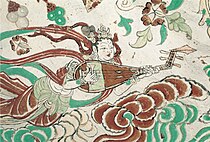Fret
This article needs additional citations for verification. (November 2018) |
A fret is any of the thin strips of material, usually metal wire, inserted laterally at specific positions along the
Frets divide the neck into fixed segments at intervals related to a musical framework. On instruments such as guitars, each fret represents one semitone in the standard western system, in which one octave is divided into twelve semitones. Fret is often used as a verb, meaning simply "to press down the string behind a fret". Fretting often refers to the frets and/or their system of placement.
Explanation
Pressing the string against the fret reduces the vibrating length of the string to that between the
Frets make it much easier for a player to achieve an acceptable standard of intonation since the frets determine the positions for the correct notes. Furthermore, a fretted fingerboard makes it easier to play chords accurately.
A disadvantage of frets is that they restrict pitches to the
Since the intonation of most modern western fretted instruments is
Many instruments' frets are not spaced according to the
system).Variations
Fan frets (also fanned frets, slanted frets), or
Scalloped fretboard:
Fat frets: on older guitars (especially the Fender Stratocaster), frets were typically made out of thin wire, and some electric guitar players replaced that with thicker wire, for "fat frets" or "jumbo frets". Fat frets make bending easier, and they change the feel of the guitar. As well, large frets, offering more metal, remain playable much longer than thin frets. A side effect of a thicker fret is a less precise note, since the string is held over a wider surface, causing a slight inaccuracy of pitch, which increases in significance as frets wear.[2]
Semi-fretted instruments
It is also possible to find semi-fretted instruments; examples include the Malagasy kabosy and the Afghan Rubab. Semi-fretted versions of guitars and other fretted string instruments, however, are usually one-off, custom adaptations made for players who want to combine elements of both types of sound. One arrangement is for the frets to extend only part of the way along the neck so that the higher notes can be played with the smooth expression possible with a fretless fingerboard. Another approach is the use of frets that extend only partway across the fretboard so that some courses of strings are fretted and others fretless, for example Ryszard Latecki's Latar.
Fret intonation
Instruments with straight frets like guitars require a special compensation on the saddle and nut. Every time a string is fretted it is also stretched, and as it stretches the string rises in pitch, making all fretted tones sound sharp. When the saddle is positioned properly, however, the fretted tones all sound sharp to the same degree as long as the distances between the frets are correct. With the right nut compensation, the pitch of the unfretted string can be raised by the same amount. As a result, when the tension of the strings is lowered, the pitches of all notes, both fretted and unfretted, become correct.
Fret wear
On instruments equipped with steel strings, such as
Tied gut frets, used on instruments such as the lute or viol, wear quickly, and must be replaced regularly.
Fret buzz
Fret buzz is one of the many undesirable phenomena that can occur on a guitar or similar
Fret buzz is evident in some famous recordings; an example is "
History
It is not known when frets were first used. An early example from about the 3rd century C.E. was discovered in 1907 in the Niya ruins in Xinjiang, China, a broken lute's neck with two gut frets intact.[4] The neck and pegbox of the lute are similar to the lute painted on the wall in the Dingjiazha Tomb No. 5 (384–441 A.D.[5]), which also has frets. Buddhist artworks from the 6th-10th centuries C.E. in the Mogao Caves (558-907 C.E.) and Yulin Caves (618-907 C.E.) appear to have frets. Some long lutes in the Utrecht Psalter (c. 850 C.E.) in France also appear fretted, as do citoles from Spain in the Cantigas de Santa Maria (c. 1280).
See also
References
- ISBN 978-1-7341256-0-3.
- ^ Hunter, Dave (February 2014). "What's the Big Deal About Jumbo Frets?". Guitar Player.
- ^ "Buzz Diagnosis". Archived from the original on 2011-01-08. Retrieved 2011-01-22.
- ^ "Lute". The British Museum.
Fragment of a wooden lute. This is only the neck of the instrument, the body has not survived...There are marks showing at the top of the fingerboard where two strands of gut, probably with a third strand on top of them to raise the height of the strings, served as a nut. The surviving doubled strand of gut was a fret, and the slightly thicker single strand may have been a fret for higher notes...Registration number 1907,1111.90
- ^ Zhu, Fengsh (September 2014). "墓主燕居行乐图探考 (translation: Exploring Yanjuxing's Tomb". 活力杂志 [Translation: Vitality Magazine]. 黑龙江 [Heilongjiang]: 黑龙江日报报业集团 [Heilongjiang Daily Newspaper Group]. Archived from the original on 24 September 2018. Retrieved 24 September 2018.
[Information about the magazine article this ran in is at www.xueshu.com/hl/201410/3683520.html]
External links
This article includes a list of general references, but it lacks sufficient corresponding inline citations. (June 2009) |
- Konrad Schwingenstein: Intonation of stringed instruments with straight frets, http://www.pepithesecond.com
- Calculating Fret Positions – An article on calculating fret positions for any equal tempered instrument on Liutaio Mottola Lutherie
- How to replace frets – Photo story
- Installing the Frets in a Fretted Stringed Musical Instrument – An article on fret installation for a new instrument on Liutaio Mottola Lutherie
- Dressing the Frets in a Fretted Stringed Musical Instrument – An article on fret dressing on Liutaio Mottola Lutherie
- Fix Guitar String Buzz – Article about guitar string buzz problems and fixes on Guitar Repair Bench
- Re-fret Bound and Unbound Fretboards – Article about removing, installing, leveling, crowning, and dressing guitar frets on Guitar Repair Bench

![{\displaystyle {\sqrt[{12}]{2}}}](https://wikimedia.org/api/rest_v1/media/math/render/svg/bc835f27425fb3140e1f75a5faa35b1e8b9efc35)



